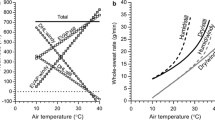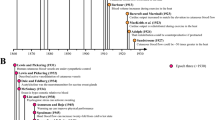Abstract
The purpose of this experiment was to determine if tolerance to exercise in the heat is related to maximal oxygen uptake (max\({\dot V}\) 02) and sweating. Seven men with max\({\dot V}\) 02 between 42 and 66 ml/(min·kg) underwent one 2-hr exposure at 24°C Tq while working on a bicycle ergometer at\(\overline {\text{X}}\) rel\({\dot V}\) 02 of 28% (\(\overline {\text{X}}\) \({\dot V}\) 02 = 1.23 1/min). In the hot exposures the high capacity subjects had maximal sweat rates of 800 to 1,000 g/(hr·m2) while the lower capacity men sweated 300 to 400 g/(hr·m2). These differences in sweating were not related to neuromuscular stimuli,\({\dot V}\) 02 (metabolic rate), Tre, ΔTre,\(\overline {\text{T}}\) s, Δ\(\overline {\text{T}}\) s or tolerance time. Tolerance to exercise in the heat was not related to maximal\({\dot V}\) 02 capacity when the subjects worked at the same relative load in spite of large differences in sweating. These results question the importance of the rate of sweating for predicting work performance in hot environments.
Zusammenfassung
Das Ziel dieser Untersuchung war, zu prüfen, ob die Toleranz bei Arbeit in der Hitze in einer Beziehung steht zur maximalen O2-Aufnahme und Schwitzen. Sieben Männer mit V02 zwischen 42 – 66 ml/(min·kg) wurden belastet während 2 Stunden bei Ta 24°C und 3 × 2 Stunden bei 47°C mit Arbeit auf dem Fahrrad-Ergometer bei im Mittel von 28% V02 = 1.23 1/min. Während der Hitzebelastung zeigten die leistungsfähigen Personen Schweissekretionsraten von 800 – 1000 g/(hr·m2) und die wenig leistungsfähigen 300 – 400 g/(hr·m2). Diese Unterschiede waren ohne Beziehung zu neuromuskulären Stimuli, Stoffwechselrate, Tre, ΔTre,\(\overline {\text{T}}\) s, Δ\(\overline {\text{T}}\) s oder der Toleranzzeit. Ausdauer bei Arbeit in der Hitze war ohne Beziehung zur maximalen V02-Kapazität, wenn die Personen bei der gleichen relativen Belastung arbeiteten tro grosser Unterschiede im Schwitzen. Die Ergebnisse stellen den Wert der Schweissekretionsrate zur Voraussage der Arbeitsleistung in der Hitze in Frage.
Resume
Dans cette étude, on a cherché à voir si la tolérance au travail sous contrainte de chaleur était en relation avec la possibilité maximum d'absorption de O2 (\({\dot V}\) 02) d'une part, de transpirer d'autre part. 7 hommes présentant des\({\dot V}\) 02 compris entre 42 et 66 ml/(min · kg) ont pédalé sur un ergomètre pendant 2 heures par une Ta de 24°C et 3 × 2 heures par 47°C et cela par une\({\dot V}\) 02 relative de 28% (\(\overline {\text{X}}\) \({\dot V}\) 02 = 1,25 1/min). Durant l'effort sous contrainte de chaleur, les plus actifs ont eu des sécrétions de sueur de 800 à 1.000 g h−1 m−2 et les moins actifs de 300 à 400 g/h · m2. Ces différences étaient sans rapport avec les stimulus neuro-musculaires, le taux de métabolisme, Tre, ΔTre, Ts et ΔTs ou la durée de tolérance. L'endurance au travail sous contrainte de chaleur n'a pas été fonction de la capacité maximum de\({\dot V}\) 02, lorsque les personnes travaillaient dans des conditions analogues, même si l'on a noté de grandes différences dans la transpiration. Ces résultats mettent en doute la représentativité du taux de sécrétion de sueur comme indicatif des possibilités de travailler en atmosphère chaude.
Similar content being viewed by others
References
ASTRAND, I. (1960): Aerobic work capacity in men and women with special reference to age. Acta Physiol. Scand., suppl. 169.
BEAN, W.B. and EICHNA, L.W. (1943): Performance in relation to environmental temperature. Reactions of normal young men to simulated desert environment. Fed. Proc., 2: 144–158.
BRADBURY, P.A., FOX, R.H., GOLDSMITH, R. and HAMPTON, I.F.G. (1964): J. Physiol. (Lond.), 171: 384–396.
DILL, D.B. and FÖLLING, A. (1928): Studies in muscular activity. II. A nomographic description of expired air. Amer. J. Physiol. 66: 133–135.
EICHNA, L.W., BEAN, W.B., ASHE, W.F. and NELSON, N. (1945): Performance in relation to environmental temperature. Reactions of normal young men to hot, humid (simulated jungle) environment. Bull. Johns Hopk. Hosp., 76: 25–58.
EKBLOM, B. (1969): Effect of physical training on oxygen transport system in man. Acta Physiol. scand., suppl. 328.
EKBLOM, B., GREENLEAF, C.J. and HERMANSEN, L. (1971): Temperature regulation during continuous and intermittent exercise in man. Acta Physiol. scand., 81: 1–10.
GREENLEAF, J.E. (1964): Lack of artificial acclimatization to heat in physically fit subjects. Nature (Lond.), 203: 1072.
GREENLEAF, J.E. and CASTLE, B.L. (1972): External auditory canal temperature as an estimate of core temperature. J. appl. Physiol., 32: 194–198.
GREENLEAF, J.E., KESSEL, A.L.van, RUFF, W., CARD, D.H. and RAPPORT, M. (1971): Exercise temperature regulation in man in the upright and supine positions. Med. Science Sports, 3: 175–182.
KOZLOWSKI, S. and SALTIN, B. (1964): Effect of sweat loss on body fluids. J. appl. Physiol., 19: 1119–1124.
NIELSEN, B. (1968): Thermoregulatory responses to arm work, leg work and intermittent leg work. Acta Physiol. Scand., 72: 25–32.
PIWONKA, R.W., ROBINSON, S., GAY, V.L. and MANALIS, R.S. (1965): Preacclimatization of men to heat by training. J. appl. Physiol., 20: 379–384.
ROWELL, L.B., KRANING II, K.K., KENNEDY, J.W. and EVANS, T.O. (1967): Central circulatory responses to work in dry heat before and after acclimatization. J. appl. Physiol., 22: 509–518.
SALTIN, B., BLOMQVIST, B., MITCHELL, J.H., JOHNSON, JR., R.L., WILDENTHAL, K. and CHAPMAN, C.B. (1968): Response to exercise after bed rest and after training. Circulation, 38: suppl. 7 : 1–78.
SALTIN, B. and HERMANSEN, L. (1966): Esophageal, rectal, and muscle temperature during exercise. J. appl. Physiol., 21: 1757–1762.
SCHOLANDER, P.F. (1947): Analyser for accurate estimation of respiratory gases in one-half cubic centimeter samples. J. biol. Chem., 167: 235–250.
SMILES, K.A. and ROBINSON, S. (1971): Regulation of sweat secretion during positive and negative work. J. appl. Physiol., 30: 409–412.
STRYDOM, N.B., WYNDHAM, C.H., WILLIAMS, C.G., MORRISON, J.F., BREDELL, G.A.G., BENADE, A.J.S. and von RAHDEN, M. (1966): Acclimatization to humid heat and the role of physical conditioning. J. appl. Physiol., 21: 636–642.
WYNDHAM, C.H., BENADE, A.J.A., WILLIAMS, C.G., STRYDOM, N.B., GOLDIN, A. and HEYNS, A.J.A. (1968): Changes in central circulation and body fluid spaces during acclimatization to heat. J. appl. Physiol., 25: 586–593.
Author information
Authors and Affiliations
Rights and permissions
About this article
Cite this article
Greenleaf, J.E., Castle, B.L. & Ruff, W.K. Maximal oxygen uptake, sweating and tolerance to exercise in the heat. Int J Biometeorol 16, 375–387 (1972). https://doi.org/10.1007/BF01553622
Received:
Issue Date:
DOI: https://doi.org/10.1007/BF01553622




